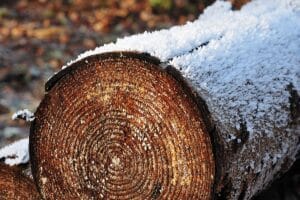It’s been almost impossible not to make money in timberland for the last 100 years. Whatever type you bought, the only trick you had to know was to hold it for a long time. The trees grew, increasing the volume of valuable timber. The trees upgraded themselves from small diameters to sawtimber diameters, and when this “in-growth” threshold was cross it multiplied a tree’s value per unit of volume many times over. You could cut some trees at the top of the stumpage cycle if you needed cash. And, finally, the dirt itself — often called “bare land” — appreciated as our population grew.
The “strategy” of holding timberland was based on the often unspoken or unexamined assumption that the U.S. economy would continue to grow over the long-term, that cyclical ups and downs would trend up over decades, that people would need to build wood-intensive houses and that wood products would continue to enjoy growing demand.
Most people who bought and held did just fine, because the underlying economic forces performed as expected and the trees grew.
In recent decades, research shows that investors have shortened the hold period. “Flipping” made both small guys and the big boys a lot of money. Buying a large tract at a wholesale price (timberland price), parting it out (cut some timber, divide the property and sell it for second-home/recreation buyers) and, maybe, putting a conservation easement on it for the tax benefits–this became a common investor strategy. Flipping shortens the hold period as much as possible.
You can, however, play the flipping game only so many times within a few years. The last flipper in line gets stuck, much like the last guy in a chain letter.
The first investor buys 100,000 acres for $1,000/A and might flip it in three chunks to second-tier flippers at $1,400/A. Each of them might flip their 33,333 acres in ten chunks for $1,700/A. The third-tier flippers might flip their 3,333 acres in ten chunks for $2,000/A. And the fourth-tier flippers might flip their 333 acres in ten chunks for $2,500/A. And sometime between the fourth tier or the fifth or the sixth, the game stops because the increasing smaller acreages have become priced above what the market will pay. At that point, the owner should simply hold and forget flipping.
Any flipper after tier 2 should be aware that the mark-up cap on resales is coming closer.
Most small timberland investors don’t apply sophisticated analytical tools to their decisions. They look at the purchase price in relation to comparable values. Or they value the assets in light of the purchase price; if the parts exceed the cost of the property as a whole, they buy. Or they estimate the value of selling some of the land’s assets, earning annual income from others and then selling the remainder at some future date for more than they have in it.
Another way of approaching a purchase is discounted cash-flow (DCF) analysis. This technique values an investment by estimating its future cash production and then discounting that number by the time value of the money invested and the risk involved. DCF can be adapted to a single cash event (i.e., buy 100 acres for $500,000 and then sell it for $750,000 five years later, leaving $250,000 in gross cash) or multiple cash events (i.e., a big tract of timberland that is managed to produce timber-sale and hunting-lease income each year, along with sometime sales of pieces of the land base). If the rate of return on the investment is zero or negative after all the costs over time are counted and all the discounts are applied, it’s not a good deal. DCF analysis must incorporate assumptions about interest rates, risk and other factors that may be little more than educated guesses. An investment that is vetted with a DCF analysis may or may not work out.
I can’t shake the feeling that we may be at a turning point in our economy, one where we can’t estimate the future in the ways we’ve used in the past. A higher embedded riskiness may be our future. This would be the long-term impact of the continuing mortgage mess, all the efforts to address it and all the needed changes that don’t seem to be on the national agenda.
Generally speaking, I continue to think that land and timberland will be better investments than stocks, bonds and commodities in the future. Land values will rise because of population growth if nothing else. As a finite resource, more people should mean continued demand and appreciating prices, even if the middle-class shrinks some as the consequence of structural changes in the economy. Timber markets, I think, will change, but the net shake out is likely to be something more diverse—traditional markets, plus biomass energy of different types. Faster growing species will bring down the cost of lumber and its products, increasing demand overall.
I’d look at timberland investments over a three-to-five year period or over a very long time, say 20 plus years. It’s the in-between period that I think is unpredictable and chancy.
The rule of thumb I’d suggest to timberland investors is something like this: If the amount of merchantable timber on a property represents at least 50 percent of the purchase price, you’re likely to make money either short-term or long-term.
This content may not be used or reproduced in any manner whatsoever, in part or in whole, without written permission of LANDTHINK. Use of this content without permission is a violation of federal copyright law. The articles, posts, comments, opinions and information provided by LANDTHINK are for informational and research purposes only and DOES NOT substitute or coincide with the advice of an attorney, accountant, real estate broker or any other licensed real estate professional. LANDTHINK strongly advises visitors and readers to seek their own professional guidance and advice related to buying, investing in or selling real estate.









A very intriguing article, Curtis. I also sense that we can no longer rely on past economic patterns to dictate the future. There is a “new normal” out there that must take into account a more global economy, possible shrinkage of the domestic market for timber in regard to housing and construction, and higher fuel costs in the transport of heavy materials like timber.
There are some bright spots. If fuel costs rise there may be an increase in the demand for paper-based containers as plastics will become more expensive. And even in this digital age some people will still print-out hard copy on paper.
Global demand for timber will increase, but the smaller trees grown in the South may not be competitive with those in the Pacific Northwest that are closer to the Asian markets and have more volume. Perhaps environmental restrictions will abate timber from the West Coast, but that shortfall will be made up with cheap timber from the Latin America, especially the Amazon basin, and Indonesia.
I do think the housing market in the United States will recover but houses will have lesser square footage and require less wood. It is even possible that rising fuel costs for smelting metal and petrochemical plastic products–aluminum or plastic sidings, insulation–could make wood more economical.
As to biomass, that is a little more iffy. Obviously, corn-based ethanol is a bit of a fiasco, but farm state voters may just keep that program going. Wood pellets for generating heat to produce steam could see there way into electricity production. But natural gas is plentiful and will be relatively cheap–unless environmental restrictions make for difficult drilling and carbon restrictions preclude implementation.
There may be new technologies that will employ wood cellulose that we can’t foresee. I know it is used in animal feed to replace corn. All-in-all, wood products will be in demand but the uses will be different and novel in the future.
And, of course, there will always be the land, itself, but I would caution that many timberland areas may have only marginal agricultural value. Hunting and recreation and a simple desire for privacy and a degree of self-sufficiency in difficult times will continue to woo some buyers. But the tracts must be large enough to accommodate privacy needs and be accessible by passable roads and not far off the grid.
You are certainly correct: “A higher embedded riskiness may be our future.” But risk begets innovation to lessen its impact.
Kurt
All-in-all, wood products will